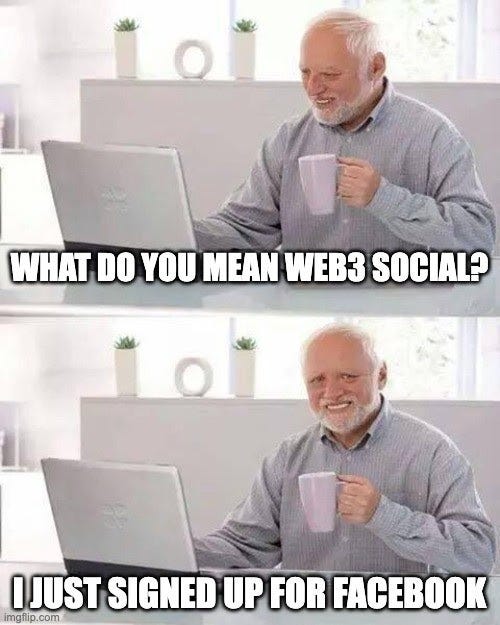Issue #8: Simple ways to start using web3 in your marketing
Happy Monday and a big welcome to the 39 new subscribers who have joined us since last week's issue.
What's coming up below:
Forget the future hypotheticals—here are some ways you can start to use web3 in your marketing right now.
Web3 social inches yet another step closer to mainstream adoption.
I'm answering the reader question: "How can I get buy-in from my team who are sceptical about web3?"
Remember to hit reply and ask me your web3-related questions, and I might just answer yours in next week's issue.
1. 5 ways to start using web3 in your brand's marketing
Much of my content in these newsletters is speculation about what might happen in the future—how the marketing world could look when web3 hits majority adoption. But what can you do as a marketer, right now?
Recently I spoke at Hubspot's annual conference, Inbound, on how you can start to use web3 in your marketing—today. Not in five years' time.
If you missed it, the talk I gave is now live on my podcast: 5 unexpected ways you can start to leverage web3 in your marketing.
Not a single one of these ways involves your brand releasing its own NFT collection, because I believe most brands don't actually need an NFT collection. Not yet, at least. And definitely not without a strategy and a real purpose behind them.
What this means for you: there are far easier ways to dabble in the web3 world than releasing an NFT collection. It's time to start thinking about how one of these methods might fit into your marketing strategy.
2. Could this be the solution to web3 social's big content problem?
One of the biggest pros of decentralised social media also creates one of its biggest challenges. In an online world where users control the platforms, how will we ensure that web3 social media is a safe and inclusive place?
Lens Protocol might have the answer.
(If you're new here: Lens Protocol is an open and permissionless social graph. In plain English, that means developers can build their own social networks easily on top of Lens, and users can sign up for one Lens handle and access any of these social networks. And none of these networks are owned by a big corporation that only cares about exploiting its users for profits).
In this recent article, Lens announced their solution for content moderation in web3 social—CultivatorDAO.
Without delving into how a DAO (decentralised autonomous organisation) works in this email—that's a whole topic in itself—this idea from Lens is a promising solution.
Lens handle holders will be able to vote on who the members of CultivatorDAO will be. These members will create guidelines on curating social content and preventing spam.
Developers of Lens Protocol social networks will have the option of turning on CultivatorDAO, and if they do, their users will be able to flag and report content they believe violates community guidelines. It's content moderation, without one centralised organisation deciding who to censor based on their own agenda.
What this means for you: spam and bots have been two of the biggest issues with web3 social so far, so solving these problems means we'll be one step closer to mainstream adoption.
3. Question of the week: How can I show my team that web3 isn’t a silly trend
Every week, I answer one of your questions submitted via email. If you have a burning question about web3, hit reply and ask it. Worst case, I'll reply directly to you with the answer. Best case, I'll answer it in the weekly email so that others can benefit from your question.
How can I get buy-in from my team? They're sceptical about web3 and think that NFTs are a silly trend for Gen Z. How can I show them that there's so much more to web3 than this?
Great question—and one that I think many marketers will be dealing with, especially if your key decision-makers are slower to adopt new technologies... Like our buddy Harold:
Perhaps your team is reluctant to dabble in web3 because they don't understand how they could use it. Or because they don't fully understand what it is. Or maybe it's because they've seen big brands like Nike release NFT collections, and they assume that this is the only approach.
Rather than selling them on the technology itself, I would show them what web3 makes possible. Sharing strategically-aligned examples (like how Starbucks is using web3 for its new loyalty program) will likely be more effective than sharing marketing stunts like Taco Bell's metaverse weddings.
Lastly, have empathy. Learning a whole new technology is scary—especially for those who have only just started to grasp Web 2.0. Avoid using jargon where possible. I think the complicated language in web3 is what scares so many people away, so explain things in simple terms. And make it clear that you're open to all of their questions, as silly as they may seem.
Good luck!
If you've made it all the way down here, that means either you found this interesting, or you're on your way to the unsubscribe button at the bottom.
Either way, I'd love it if you could please take 2 minutes to let me know how I'm doing. What would you like to see more of? Less of?
Until next week,
Steph
PS. Did someone forward you this email? Click here to get the weekly emails straight to your inbox, minus the middleman.
This should go without saying, but I am a marketer, not a financial advisor. The content in this email is for educational purposes only and should not be taken as financial advice. Please take care and do your own research before investing in any web3 projects.


